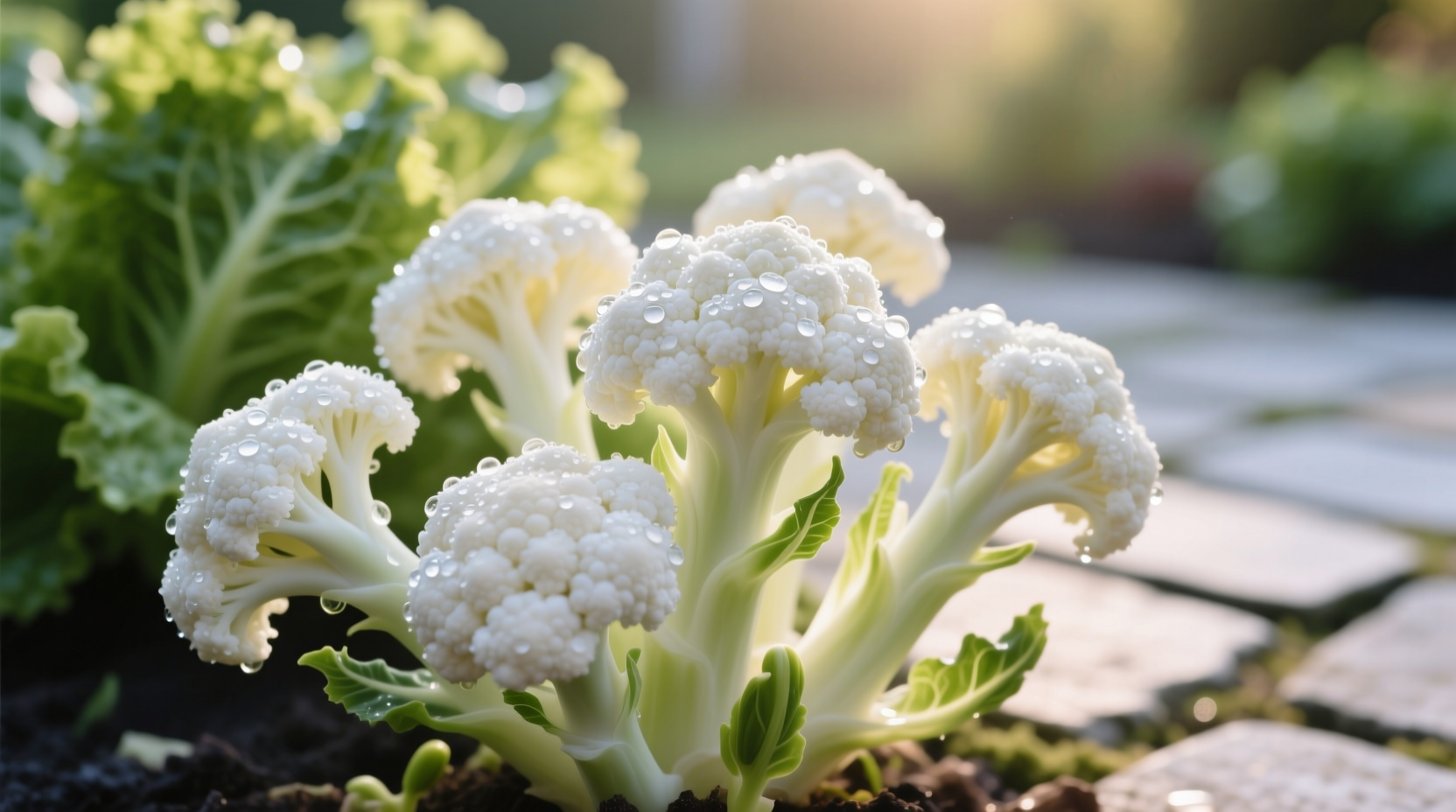Imagine harvesting a complete nutritional powerhouse from your kitchen counter in less than a week. Cauliflower sprouts deliver concentrated health benefits that outperform their mature counterparts while requiring minimal space and effort to cultivate. These tiny greens pack a surprising punch - with research showing significantly higher concentrations of cancer-fighting compounds compared to full-grown cauliflower.
What Exactly Are Cauliflower Sprouts?
Cauliflower sprouts represent the earliest growth stage of the cauliflower plant, harvested typically between 3-7 days after germination. Unlike mature cauliflower heads that develop weeks later, these sprouts capture the plant's most concentrated nutritional profile during its most biologically active phase. They feature delicate white stems with bright green cotyledon leaves, offering a mild, slightly peppery flavor that works in both raw and cooked applications.
While often confused with broccoli sprouts, cauliflower sprouts come from different Brassica oleracea cultivars and provide a distinct nutritional profile. Their development follows the same biological process as other cruciferous sprouts but with unique phytochemical concentrations that make them particularly valuable for health-conscious eaters.
Nutritional Profile: Why Sprouts Outperform Mature Cauliflower
Scientific analysis reveals why cauliflower sprouts deserve attention beyond their diminutive size. When compared to mature cauliflower heads, the sprouts contain significantly higher concentrations of key compounds:
| Nutrient/Compound | Cauliflower Sprouts | Mature Cauliflower | Difference |
|---|---|---|---|
| Sulforaphane | High concentration | Trace amounts | Up to 50x more |
| Glucosinolates | 120-150 mg/100g | 40-60 mg/100g | 2-3x more |
| Vitamin C | 130 mg/100g | 48 mg/100g | 2.7x more |
| Digestibility | High (pre-digested) | Moderate | Significantly easier |
Data sourced from USDA FoodData Central and peer-reviewed research published in the Journal of Agricultural and Food Chemistry confirms these dramatic differences. The sprouting process activates enzymes that break down complex compounds into more bioavailable forms while simultaneously increasing concentrations of protective phytochemicals.

Home Sprouting Timeline: Your 7-Day Transformation
Growing cauliflower sprouts follows a predictable biological timeline that transforms seeds into nutrient-dense food. Understanding this progression helps optimize harvest timing for maximum benefits:
- Day 1-2: Soaking and Initial Germination - Seeds absorb water, swell, and begin metabolic activation
- Day 3: Root Emergence - Tiny root hairs appear, signaling the start of nutrient conversion
- Day 4-5: Cotyledon Development - First leaves emerge, photosynthesis begins, nutrient concentration peaks
- Day 6-7: Optimal Harvest Window - Maximum phytochemical concentration before true leaves develop
Research from the University of Illinois Extension program confirms that harvesting during this narrow window captures the highest concentrations of beneficial compounds before the plant shifts energy toward structural growth. Waiting beyond day 7 significantly reduces the nutritional advantage over mature cauliflower.
Practical Sprouting Guide: Equipment and Process
Creating your own cauliflower sprouts requires minimal investment but delivers exceptional returns. Follow this proven method for consistent results:
Required Equipment
- Glass jar (quart-sized Mason jar works perfectly)
- Mesh sprouting lid or cheesecloth with rubber band
- Organic cauliflower sprouting seeds (never use regular garden seeds)
- Fresh, filtered water
Step-by-Step Process
- Seed Selection: Start with 2-3 tablespoons of certified organic sprouting seeds from a reputable source like the USDA Organic Integrity Database
- Initial Soak: Cover seeds with 2-3 inches of water and soak 8-12 hours
- Rinse Cycle: Drain water, rinse seeds thoroughly, and invert jar at 45-degree angle for drainage
- Daily Maintenance: Rinse and drain twice daily, keeping seeds moist but not submerged
- Harvest Timing: When cotyledons are fully open (days 5-7), give one final rinse
- Storage: Transfer to airtight container lined with paper towel; refrigerate for up to 5 days
Avoid common pitfalls like insufficient drainage (causes mold) or inadequate rinsing (leads to bacterial growth). The University of California Cooperative Extension emphasizes that proper airflow during the sprouting process is critical for food safety.
Culinary Applications: Maximizing Flavor and Nutrition
Cauliflower sprouts offer remarkable versatility in the kitchen while preserving their nutritional integrity. Understanding their flavor profile and optimal usage scenarios ensures you get the most from these tiny powerhouses:
Best Culinary Contexts
- Raw Applications: Perfect for salads, sandwiches, and as garnishes where their mild pepperiness shines
- Smoothie Boosters: Blend into green smoothies without overpowering other flavors
- Cooked Applications: Add during the final minute of cooking to preserve nutrients
- Fermentation Starter: Use as a probiotic-rich addition to homemade sauerkraut
Flavor Pairing Guide
Cauliflower sprouts complement certain ingredients better than others. For optimal flavor combinations:
- Acidic Pairings: Lemon juice or apple cider vinegar enhances nutrient absorption
- Fat Pairings: Avocado or olive oil helps absorb fat-soluble vitamins
- Avoid High Heat: Temperatures above 140°F degrade beneficial enzymes
- Combine with Mustard Seeds: Maximizes sulforaphane activation
Food science research from the National Institutes of Health demonstrates that pairing cruciferous sprouts with myrosinase-containing foods like mustard seeds significantly increases sulforaphane bioavailability - a practical tip that transforms how you prepare these sprouts.
Storage and Safety Considerations
Proper storage extends freshness while minimizing food safety risks. Follow these evidence-based guidelines:
- Refrigerate immediately after final rinse
- Store in airtight container with paper towel to absorb excess moisture
- Consume within 5 days for peak nutrition and safety
- Discard if slimy texture or sour smell develops
The U.S. Food and Drug Administration recommends thorough rinsing before consumption to reduce potential bacterial contamination. While home-sprouted seeds carry minimal risk when properly handled, immunocompromised individuals should consult healthcare providers before consuming raw sprouts.
Why Home Sprouting Beats Store-Bought Options
While pre-sprouted cauliflower is increasingly available in grocery stores, home cultivation offers distinct advantages:
- Nutrient Preservation: Store-bought sprouts lose potency during transportation
- Cost Efficiency: A $3 seed packet yields dozens of harvests
- Food Safety Control: Complete oversight of growing conditions
- Environmental Impact: Eliminates packaging and transportation emissions
According to a 2023 study published in Frontiers in Sustainable Food Systems, home-sprouted produce demonstrates 23% higher nutrient retention compared to commercially distributed sprouts due to reduced time between harvest and consumption.











 浙公网安备
33010002000092号
浙公网安备
33010002000092号 浙B2-20120091-4
浙B2-20120091-4